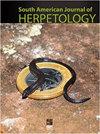加那利群岛特内里费岛两个生态对比种群delalandii Tarentola(鳞片目:Phyllodactylidae)外寄生体数量的季节、体态和性别差异
IF 0.7
4区 生物学
Q4 ZOOLOGY
引用次数: 0
摘要
摘要个体寄生虫载量取决于几个因素,如性别、体型或气候条件。反过来,寄生虫可能会产生几种短期和长期的疾病。在此,我们分析了两个生态对比种群(特内里费岛北部和南部)中壁虎螨的体外寄生虫负荷。为此,我们对每个种群的岩石下壁虎进行了随机取样,并统计了在每个壁虎身体任何部位发现的所有螨虫。广义线性模型显示,避难所的地点、季节、性别(种群内)、条件指数或温度对螨的丰度没有显著影响。然而,季节性条件指数和季节性(嵌套在种群中)之间的相互作用有显著影响。秋冬季节身体指数值较低的个体的寄生虫感染率高于春夏季节身体状况较高的个体。此外,在一年中较冷的月份,北方种群中的雌性比雄性和幼年更容易被寄生。我们讨论了对这些结果的几种可能的解释。本文章由计算机程序翻译,如有差异,请以英文原文为准。
Season, Body Condition, and Sex Variation of Ectoparasite Abundance in Tarentola delalandii (Squamata: Phyllodactylidae) from Two Ecologically Contrasting Populations of Tenerife (Canary Islands)
Abstract. Individual parasite load depends on several factors such as sex, body size or climatic conditions. In turn, parasites may produce several short- and long-term pathologies. Herein, we analyze the ectoparasite load of the Geckobia mite in two ecologically contrasting populations (north and south of Tenerife) of the gecko Tarentola delalandii. For this purpose, we performed random transects to capture geckos under rocks in each population and counted all mites found on any part of each gecko's body. A generalized linear model showed no significant effect on mite abundance of site, season, sex (within population), condition index, or temperature of the refuges. However, there were significant effects of the interactions between season by condition index and season by sex (nested within population). Parasitism was higher in individuals with lower body index values in autumn–winter than those with higher body condition in spring–summer. Moreover, females of the northern population were more heavily parasitized than males and juveniles in the year's cooler months. We discuss several potential explanations for these results.
求助全文
通过发布文献求助,成功后即可免费获取论文全文。
去求助
来源期刊
CiteScore
1.50
自引率
0.00%
发文量
10
期刊介绍:
The South American Journal of Herpetology (SAJH) is an international journal published by the Brazilian Society of Herpetology that aims to provide an effective medium of communication for the international herpetological community. SAJH publishes peer-reviewed original contributions on all subjects related to the biology of amphibians and reptiles, including descriptive, comparative, inferential, and experimental studies and taxa from anywhere in the world, as well as theoretical studies that explore principles and methods.

 求助内容:
求助内容: 应助结果提醒方式:
应助结果提醒方式:


